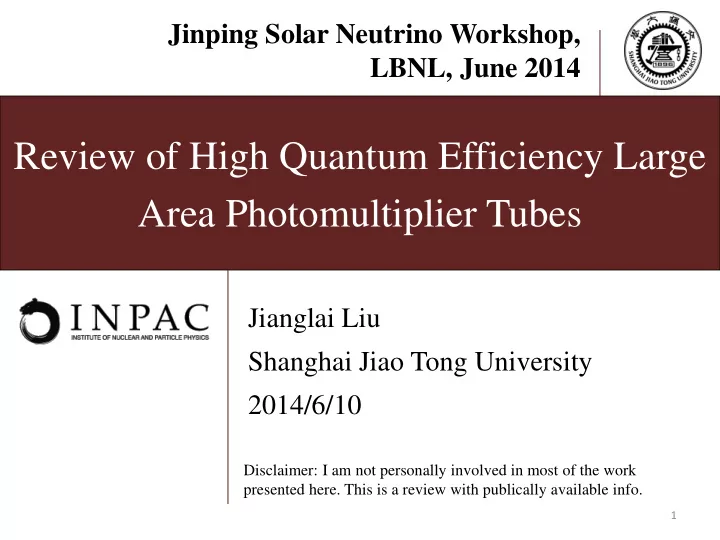

Jinping Solar Neutrino Workshop, LBNL, June 2014 Review of High Quantum Efficiency Large Area Photomultiplier Tubes Jianglai Liu Shanghai Jiao Tong University 2014/6/10 Disclaimer: I am not personally involved in most of the work presented here. This is a review with publically available info. 1
PMTs and Large Detectors MILAGRO KamLAND Daya Bay JUNO For large scale and photon-hungry experiments, large area photomultipliers are still by far the most economical and mature technology 2
Large area photomultiplier family Hamamatsu 20-in 13-in 10-in 8-in R3600-02 R5912 R7081 R8055 R7250 3
Photocathode Quantum efficiency = probability of a photon converted to a electron in the vacuum (free from the cathode) 4
Photocathode materials Many options: Bialkali is a popular type (QE curve matches the LS and NaI emission spectrum) and its low thermal noise, Sb-Rb-Cs/Sb-K- Cs/Sb-Na-Cs 5
Ways to enhance QE? They worked with commercial companies to improve the technology. 6
Ways to enhance QE Impurity reduce electron escape depth Anti-reflective ~10-20 atom layers layer Enhance e escape length (some experts argue 99.9% is sufficient) 10-20 atomic layer 7
Coating on the glass Likely to be difficult for large PMTs with stringent chemical compatibility requirements 8
Winston cone • Smart optical “trap” • Considered for LBNE to enhance the light collection • Simulation with water indicate 50% gain 9
Recent development (commercial) Hamamatsu • Photonics reported similar high QE PMTs as well • Improvements likely lie within the points Mirzoyan et al. stressed 10
Top commercial candidates • 10” - 20” considered by 10” LBNE 8” • Hamamatsu high QE versions available. • Not aware if ET and 20” 12” Photonics high QE version available for large area 11
Hamamatsu Super BiAlkali (SBA) photomultipliers Dimensions of R7081 (Hamamatsu datasheet) Quantum efficiency of a SBA and a standard R7081 (Hamamatsu internal communication) 12
R7081-02 (10-in) • IceCube (A. Karle) QE SBA increase @ 410 nm [%] • NEMO (E. Leonora) SBA PMT 1 37.7 SBA PMT 2 32.1 SBA PMT 3 39.7 SBA PMT 4 36.1 Two groups have consistent results: QE up 30-40%, dark noise up (<2 kHz to 3 kHz), afterpulsing worsen (4%->11%) 13
R11780 (12-in) Brack et al., NIMA 712 p162-173 (2013) • The dark noise shows a similar trend. • The afterpulse does not appear to change between the normal and HQE version. 14
R3600 (20-in) • HyperK collaboration is making good progress on the 20-in PMTs (Y. Suda , TIPP’14) • Clearly the HQE version of the 20” PMTs are better than the old SK tubes. • The collaboration is also working on alternative hybrid PMT solution. 15
Alternative approach Aside from mysterious cathode alchemy, usual complaints about are • limited incident angle coverage • complicated dynode structure (expensive) • low PE collection efficiency (70%) Several promising alternatives • Hybrid photo-diode (HPD) • MCP-PMT 16
Hybrid phototubes with luminescent screen Quasar370, used in Lake Baikal underwater neutrino telescope in 90 th (B. K. Lubsandorzhiev) E. Lorenz and D. Ferenc 17
Hybrid APD-PMT Y. Suda , TIPP’14 5 mm (target 20 mm) • Replace the dynode with an avalanch diode • Pros: • No dynode so simpler structure = cheaper • High first stage gain = best SPE resolution • Shoft drift length = good timing • Cons: • HV high (8 kV) • Preamp needed since the gain is ~10 5 18
20-in HPD Y. Suda , TIPP’14 20-in HPD prototype with 5 mm AD • HPD timing and SPE response very good compared to regular PMTs • HyperK expects to decide photon sensor technology by 2016 19
Other HPD examples Less metal materials from dynodes and stems less radioactivity, critical for DM searches QUPID, Katsushi Arisaka, H. Wang Not widely used in DM experiments yet. 20
HPD with very high QE: GaAsP cathode Used in MAGIC II M. Teshima GaAsP emerges as a strong HQE cathode material, but expensive and not available for large area 21
Transmission and reflective photocathode • Cathode: can we make use of the reflective PE as well? • Dynode structure is a blockage to the photoelectrons 22
New type of MCP-PMT S. Qian, NDIP2011 • Effort led by Y. F. Wang, a collaboration between IHEP and commercial companies in China • One photosensor option for the JUNO Experiment. 23
Multichannel plates Commercially available in imaging/vision business Operating at 2 kV, with 10 5 gain S. L. Liu, TIPP’14 24
Prototypes 20-in 8-in S. L. Liu, TIPP’14 25
8-in test results • Much progress in the past a couple of years • Results of MCP-PMT is encouraging • The collaboration will make a decision on the photosensor technology in not-to-far future 26
Summary • HQE crucial for large scale experiments: • more lights more physics potential • brings the cost down • Commercial HQE option, Hamamatsu in particular, are available and mature. QE of ~35% consistently reported for 10” - 20” tubes • There are strong incentives for alternative hybrid PMTs (HyperK, JUNO). Such products might be available in few years time scale. 27
Recommend
More recommend